BA Business Management: International Financial Management Report
VerifiedAdded on 2022/12/14
|9
|1856
|63
Report
AI Summary
This report provides an analysis of international financial management, focusing on investment decision-making processes. It explores three distinct case scenarios to illustrate financial decision-making concepts. The first case examines cost analysis, comparing self-production versus supplier options, considering factors such as present value of cash outflows. The second case delves into cost management, emphasizing the importance of timing in incurring costs, such as tree-cutting operations, to minimize financial impact. The third case utilizes the Net Present Value (NPV) technique to evaluate project viability, factoring in inflation and discount rates to determine the economic feasibility of an investment. The report concludes by emphasizing the role of cost considerations in financial decisions and the importance of NPV in assessing investment opportunities.
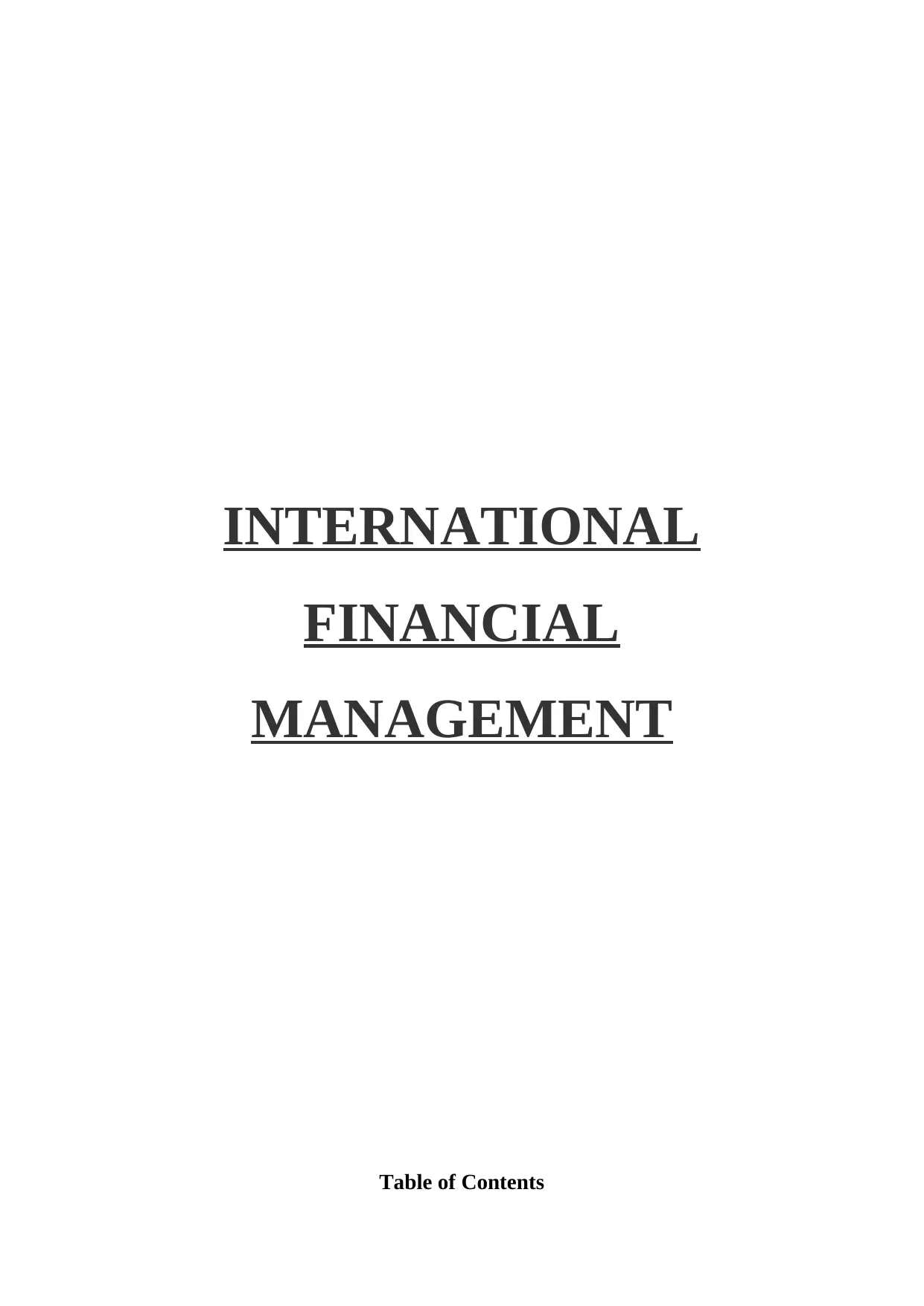
INTERNATIONAL
FINANCIAL
MANAGEMENT
Table of Contents
FINANCIAL
MANAGEMENT
Table of Contents
Paraphrase This Document
Need a fresh take? Get an instant paraphrase of this document with our AI Paraphraser

INTRPDUCTION..................................................................................................................................3
Question 1.............................................................................................................................................3
Question 2.............................................................................................................................................5
QUESTION 3........................................................................................................................................5
CONCLUSION.....................................................................................................................................8
REFERENCES......................................................................................................................................9
Question 1.............................................................................................................................................3
Question 2.............................................................................................................................................5
QUESTION 3........................................................................................................................................5
CONCLUSION.....................................................................................................................................8
REFERENCES......................................................................................................................................9
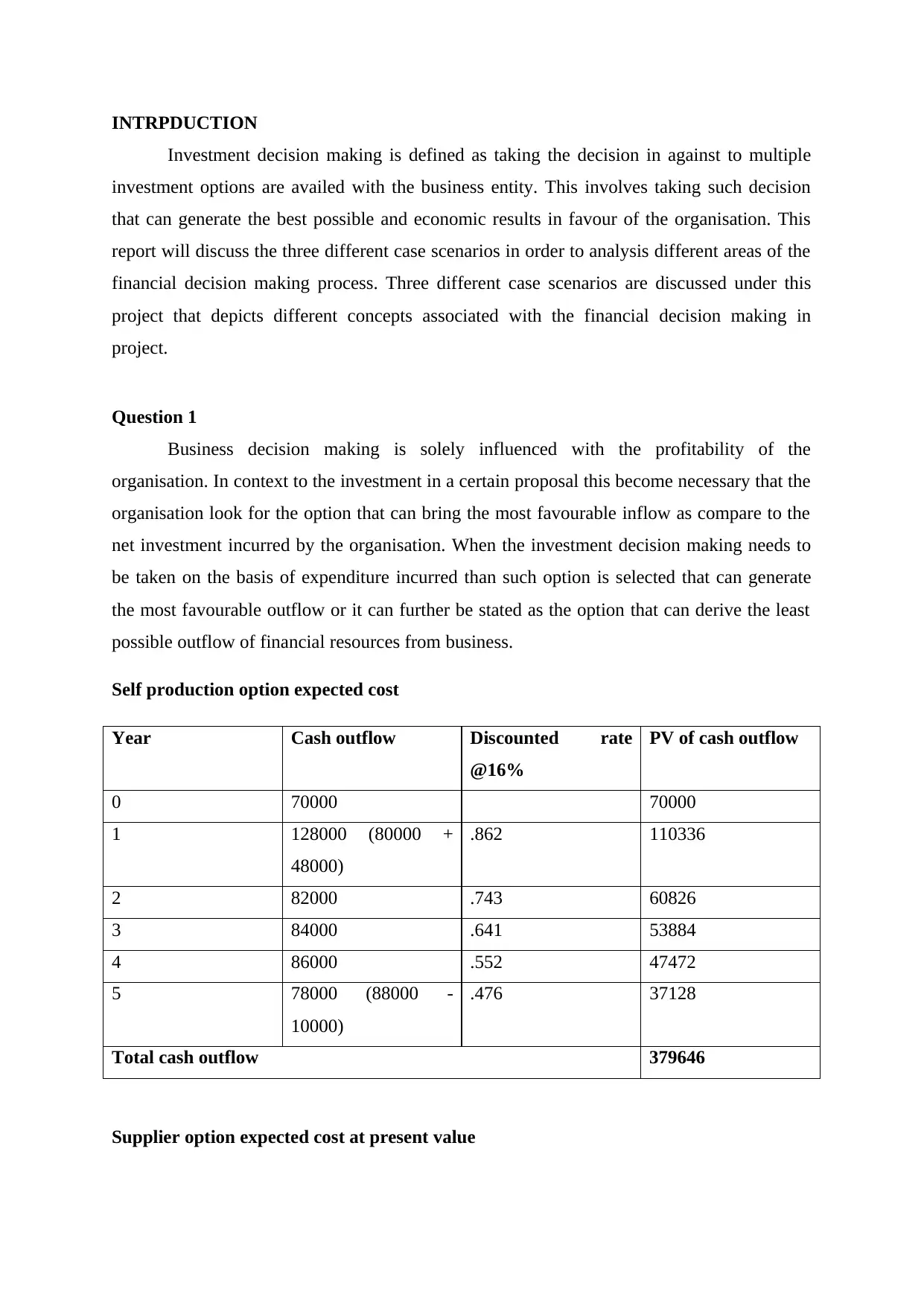
INTRPDUCTION
Investment decision making is defined as taking the decision in against to multiple
investment options are availed with the business entity. This involves taking such decision
that can generate the best possible and economic results in favour of the organisation. This
report will discuss the three different case scenarios in order to analysis different areas of the
financial decision making process. Three different case scenarios are discussed under this
project that depicts different concepts associated with the financial decision making in
project.
Question 1
Business decision making is solely influenced with the profitability of the
organisation. In context to the investment in a certain proposal this become necessary that the
organisation look for the option that can bring the most favourable inflow as compare to the
net investment incurred by the organisation. When the investment decision making needs to
be taken on the basis of expenditure incurred than such option is selected that can generate
the most favourable outflow or it can further be stated as the option that can derive the least
possible outflow of financial resources from business.
Self production option expected cost
Year Cash outflow Discounted rate
@16%
PV of cash outflow
0 70000 70000
1 128000 (80000 +
48000)
.862 110336
2 82000 .743 60826
3 84000 .641 53884
4 86000 .552 47472
5 78000 (88000 -
10000)
.476 37128
Total cash outflow 379646
Supplier option expected cost at present value
Investment decision making is defined as taking the decision in against to multiple
investment options are availed with the business entity. This involves taking such decision
that can generate the best possible and economic results in favour of the organisation. This
report will discuss the three different case scenarios in order to analysis different areas of the
financial decision making process. Three different case scenarios are discussed under this
project that depicts different concepts associated with the financial decision making in
project.
Question 1
Business decision making is solely influenced with the profitability of the
organisation. In context to the investment in a certain proposal this become necessary that the
organisation look for the option that can bring the most favourable inflow as compare to the
net investment incurred by the organisation. When the investment decision making needs to
be taken on the basis of expenditure incurred than such option is selected that can generate
the most favourable outflow or it can further be stated as the option that can derive the least
possible outflow of financial resources from business.
Self production option expected cost
Year Cash outflow Discounted rate
@16%
PV of cash outflow
0 70000 70000
1 128000 (80000 +
48000)
.862 110336
2 82000 .743 60826
3 84000 .641 53884
4 86000 .552 47472
5 78000 (88000 -
10000)
.476 37128
Total cash outflow 379646
Supplier option expected cost at present value
⊘ This is a preview!⊘
Do you want full access?
Subscribe today to unlock all pages.

Trusted by 1+ million students worldwide
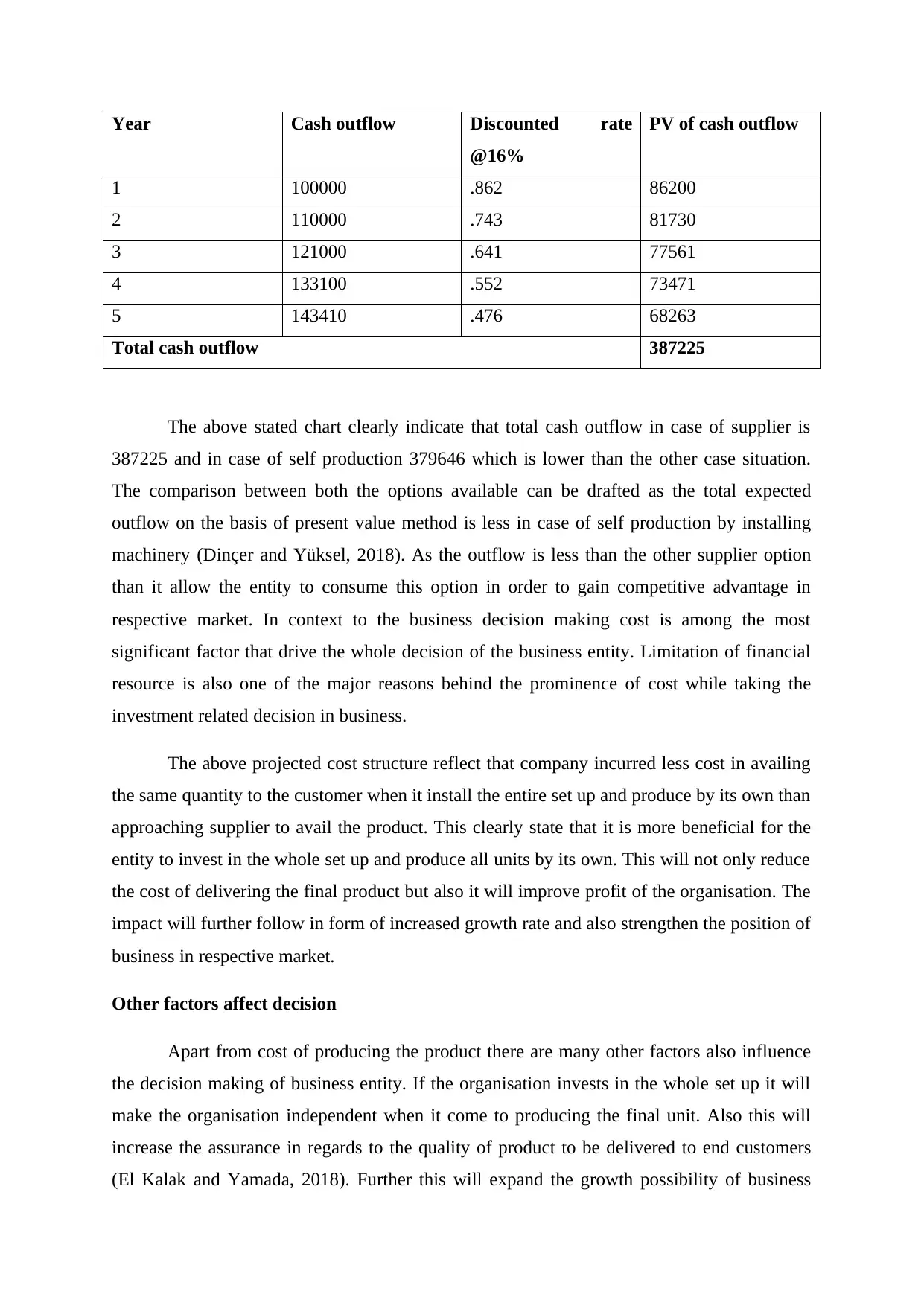
Year Cash outflow Discounted rate
@16%
PV of cash outflow
1 100000 .862 86200
2 110000 .743 81730
3 121000 .641 77561
4 133100 .552 73471
5 143410 .476 68263
Total cash outflow 387225
The above stated chart clearly indicate that total cash outflow in case of supplier is
387225 and in case of self production 379646 which is lower than the other case situation.
The comparison between both the options available can be drafted as the total expected
outflow on the basis of present value method is less in case of self production by installing
machinery (Dinçer and Yüksel, 2018). As the outflow is less than the other supplier option
than it allow the entity to consume this option in order to gain competitive advantage in
respective market. In context to the business decision making cost is among the most
significant factor that drive the whole decision of the business entity. Limitation of financial
resource is also one of the major reasons behind the prominence of cost while taking the
investment related decision in business.
The above projected cost structure reflect that company incurred less cost in availing
the same quantity to the customer when it install the entire set up and produce by its own than
approaching supplier to avail the product. This clearly state that it is more beneficial for the
entity to invest in the whole set up and produce all units by its own. This will not only reduce
the cost of delivering the final product but also it will improve profit of the organisation. The
impact will further follow in form of increased growth rate and also strengthen the position of
business in respective market.
Other factors affect decision
Apart from cost of producing the product there are many other factors also influence
the decision making of business entity. If the organisation invests in the whole set up it will
make the organisation independent when it come to producing the final unit. Also this will
increase the assurance in regards to the quality of product to be delivered to end customers
(El Kalak and Yamada, 2018). Further this will expand the growth possibility of business
@16%
PV of cash outflow
1 100000 .862 86200
2 110000 .743 81730
3 121000 .641 77561
4 133100 .552 73471
5 143410 .476 68263
Total cash outflow 387225
The above stated chart clearly indicate that total cash outflow in case of supplier is
387225 and in case of self production 379646 which is lower than the other case situation.
The comparison between both the options available can be drafted as the total expected
outflow on the basis of present value method is less in case of self production by installing
machinery (Dinçer and Yüksel, 2018). As the outflow is less than the other supplier option
than it allow the entity to consume this option in order to gain competitive advantage in
respective market. In context to the business decision making cost is among the most
significant factor that drive the whole decision of the business entity. Limitation of financial
resource is also one of the major reasons behind the prominence of cost while taking the
investment related decision in business.
The above projected cost structure reflect that company incurred less cost in availing
the same quantity to the customer when it install the entire set up and produce by its own than
approaching supplier to avail the product. This clearly state that it is more beneficial for the
entity to invest in the whole set up and produce all units by its own. This will not only reduce
the cost of delivering the final product but also it will improve profit of the organisation. The
impact will further follow in form of increased growth rate and also strengthen the position of
business in respective market.
Other factors affect decision
Apart from cost of producing the product there are many other factors also influence
the decision making of business entity. If the organisation invests in the whole set up it will
make the organisation independent when it come to producing the final unit. Also this will
increase the assurance in regards to the quality of product to be delivered to end customers
(El Kalak and Yamada, 2018). Further this will expand the growth possibility of business
Paraphrase This Document
Need a fresh take? Get an instant paraphrase of this document with our AI Paraphraser
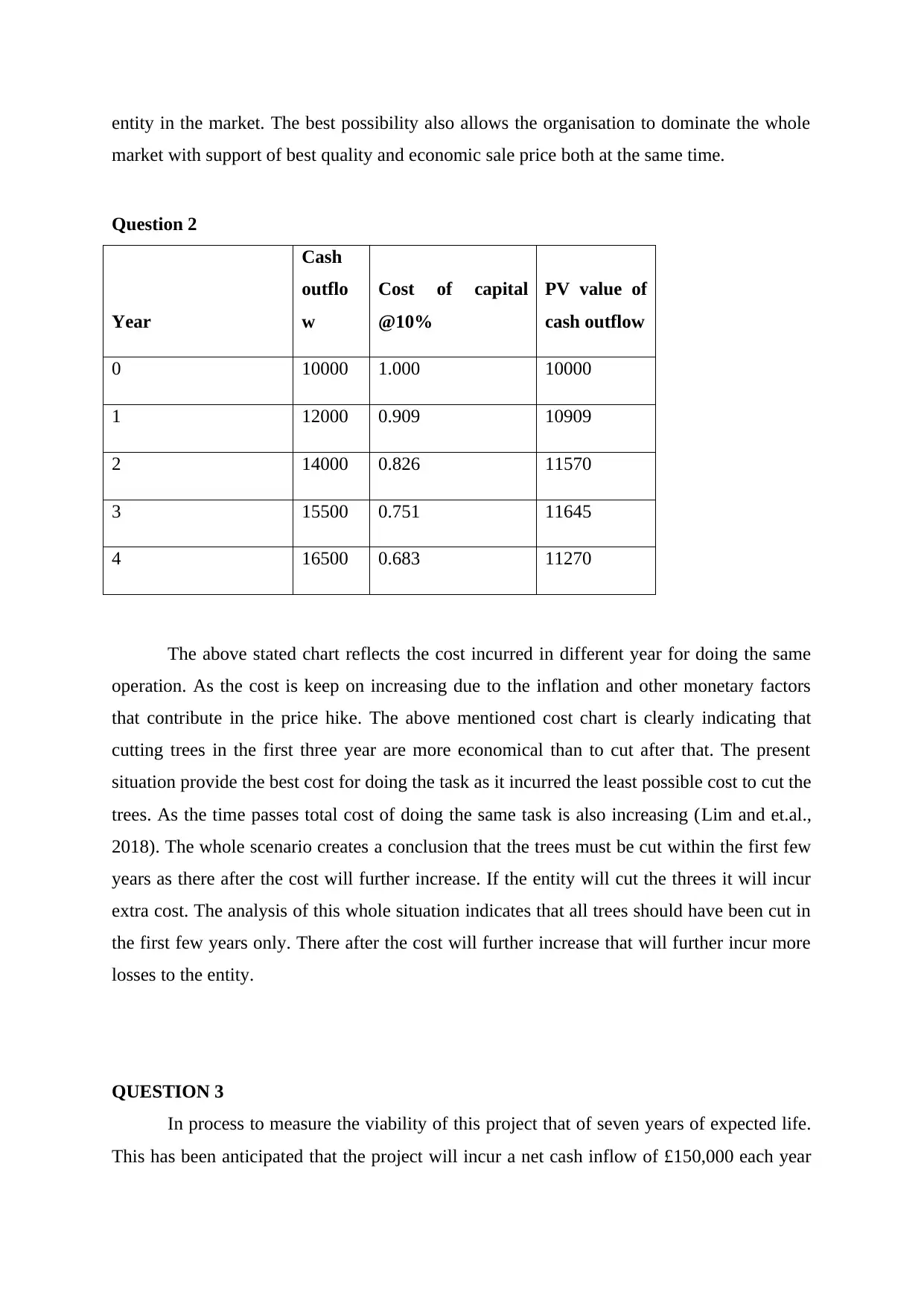
entity in the market. The best possibility also allows the organisation to dominate the whole
market with support of best quality and economic sale price both at the same time.
Question 2
Year
Cash
outflo
w
Cost of capital
@10%
PV value of
cash outflow
0 10000 1.000 10000
1 12000 0.909 10909
2 14000 0.826 11570
3 15500 0.751 11645
4 16500 0.683 11270
The above stated chart reflects the cost incurred in different year for doing the same
operation. As the cost is keep on increasing due to the inflation and other monetary factors
that contribute in the price hike. The above mentioned cost chart is clearly indicating that
cutting trees in the first three year are more economical than to cut after that. The present
situation provide the best cost for doing the task as it incurred the least possible cost to cut the
trees. As the time passes total cost of doing the same task is also increasing (Lim and et.al.,
2018). The whole scenario creates a conclusion that the trees must be cut within the first few
years as there after the cost will further increase. If the entity will cut the threes it will incur
extra cost. The analysis of this whole situation indicates that all trees should have been cut in
the first few years only. There after the cost will further increase that will further incur more
losses to the entity.
QUESTION 3
In process to measure the viability of this project that of seven years of expected life.
This has been anticipated that the project will incur a net cash inflow of £150,000 each year
market with support of best quality and economic sale price both at the same time.
Question 2
Year
Cash
outflo
w
Cost of capital
@10%
PV value of
cash outflow
0 10000 1.000 10000
1 12000 0.909 10909
2 14000 0.826 11570
3 15500 0.751 11645
4 16500 0.683 11270
The above stated chart reflects the cost incurred in different year for doing the same
operation. As the cost is keep on increasing due to the inflation and other monetary factors
that contribute in the price hike. The above mentioned cost chart is clearly indicating that
cutting trees in the first three year are more economical than to cut after that. The present
situation provide the best cost for doing the task as it incurred the least possible cost to cut the
trees. As the time passes total cost of doing the same task is also increasing (Lim and et.al.,
2018). The whole scenario creates a conclusion that the trees must be cut within the first few
years as there after the cost will further increase. If the entity will cut the threes it will incur
extra cost. The analysis of this whole situation indicates that all trees should have been cut in
the first few years only. There after the cost will further increase that will further incur more
losses to the entity.
QUESTION 3
In process to measure the viability of this project that of seven years of expected life.
This has been anticipated that the project will incur a net cash inflow of £150,000 each year
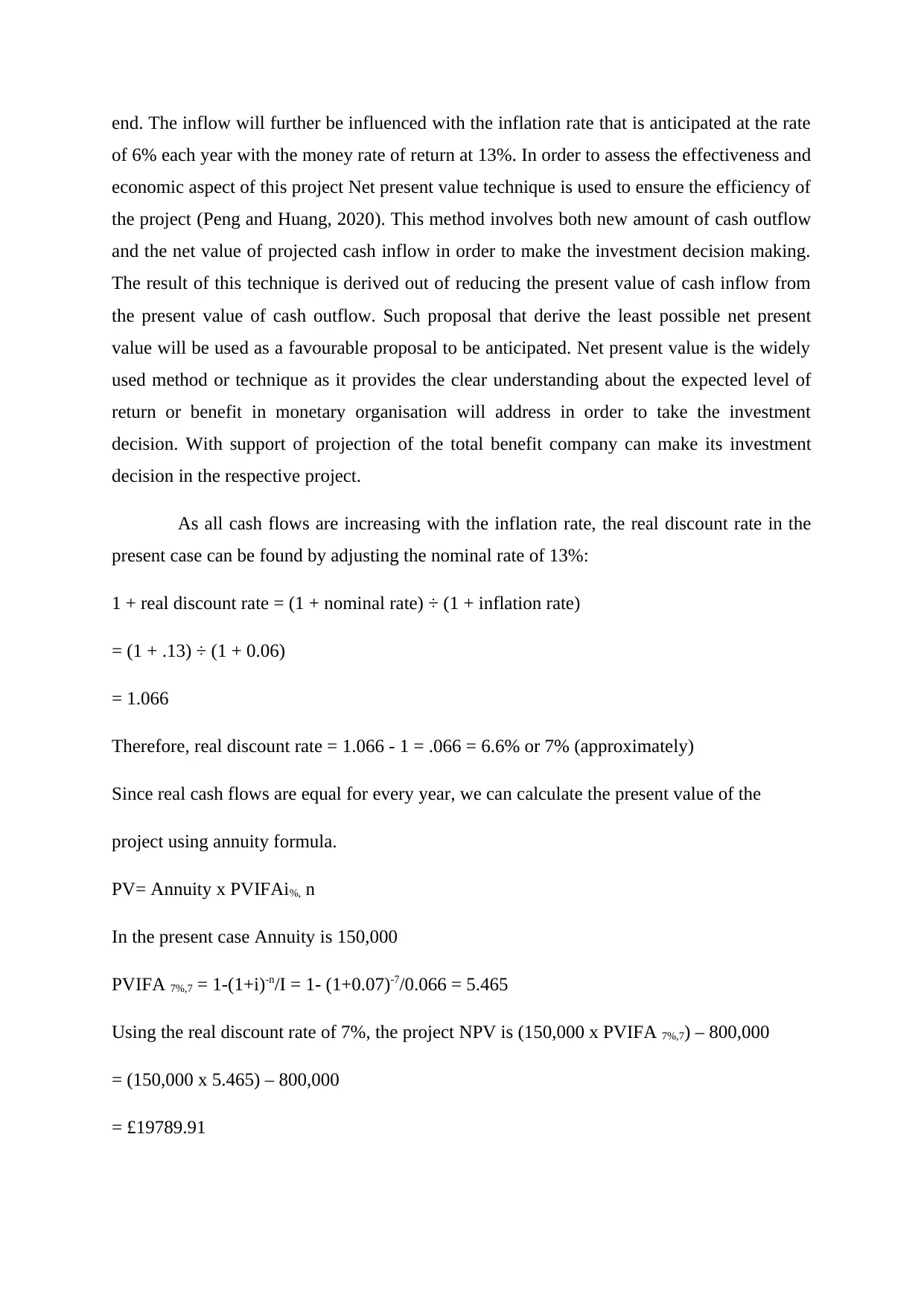
end. The inflow will further be influenced with the inflation rate that is anticipated at the rate
of 6% each year with the money rate of return at 13%. In order to assess the effectiveness and
economic aspect of this project Net present value technique is used to ensure the efficiency of
the project (Peng and Huang, 2020). This method involves both new amount of cash outflow
and the net value of projected cash inflow in order to make the investment decision making.
The result of this technique is derived out of reducing the present value of cash inflow from
the present value of cash outflow. Such proposal that derive the least possible net present
value will be used as a favourable proposal to be anticipated. Net present value is the widely
used method or technique as it provides the clear understanding about the expected level of
return or benefit in monetary organisation will address in order to take the investment
decision. With support of projection of the total benefit company can make its investment
decision in the respective project.
As all cash flows are increasing with the inflation rate, the real discount rate in the
present case can be found by adjusting the nominal rate of 13%:
1 + real discount rate = (1 + nominal rate) ÷ (1 + inflation rate)
= (1 + .13) ÷ (1 + 0.06)
= 1.066
Therefore, real discount rate = 1.066 - 1 = .066 = 6.6% or 7% (approximately)
Since real cash flows are equal for every year, we can calculate the present value of the
project using annuity formula.
PV= Annuity x PVIFAi%, n
In the present case Annuity is 150,000
PVIFA 7%,7 = 1-(1+i)-n/I = 1- (1+0.07)-7/0.066 = 5.465
Using the real discount rate of 7%, the project NPV is (150,000 x PVIFA 7%,7) – 800,000
= (150,000 x 5.465) – 800,000
= £19789.91
of 6% each year with the money rate of return at 13%. In order to assess the effectiveness and
economic aspect of this project Net present value technique is used to ensure the efficiency of
the project (Peng and Huang, 2020). This method involves both new amount of cash outflow
and the net value of projected cash inflow in order to make the investment decision making.
The result of this technique is derived out of reducing the present value of cash inflow from
the present value of cash outflow. Such proposal that derive the least possible net present
value will be used as a favourable proposal to be anticipated. Net present value is the widely
used method or technique as it provides the clear understanding about the expected level of
return or benefit in monetary organisation will address in order to take the investment
decision. With support of projection of the total benefit company can make its investment
decision in the respective project.
As all cash flows are increasing with the inflation rate, the real discount rate in the
present case can be found by adjusting the nominal rate of 13%:
1 + real discount rate = (1 + nominal rate) ÷ (1 + inflation rate)
= (1 + .13) ÷ (1 + 0.06)
= 1.066
Therefore, real discount rate = 1.066 - 1 = .066 = 6.6% or 7% (approximately)
Since real cash flows are equal for every year, we can calculate the present value of the
project using annuity formula.
PV= Annuity x PVIFAi%, n
In the present case Annuity is 150,000
PVIFA 7%,7 = 1-(1+i)-n/I = 1- (1+0.07)-7/0.066 = 5.465
Using the real discount rate of 7%, the project NPV is (150,000 x PVIFA 7%,7) – 800,000
= (150,000 x 5.465) – 800,000
= £19789.91
⊘ This is a preview!⊘
Do you want full access?
Subscribe today to unlock all pages.

Trusted by 1+ million students worldwide
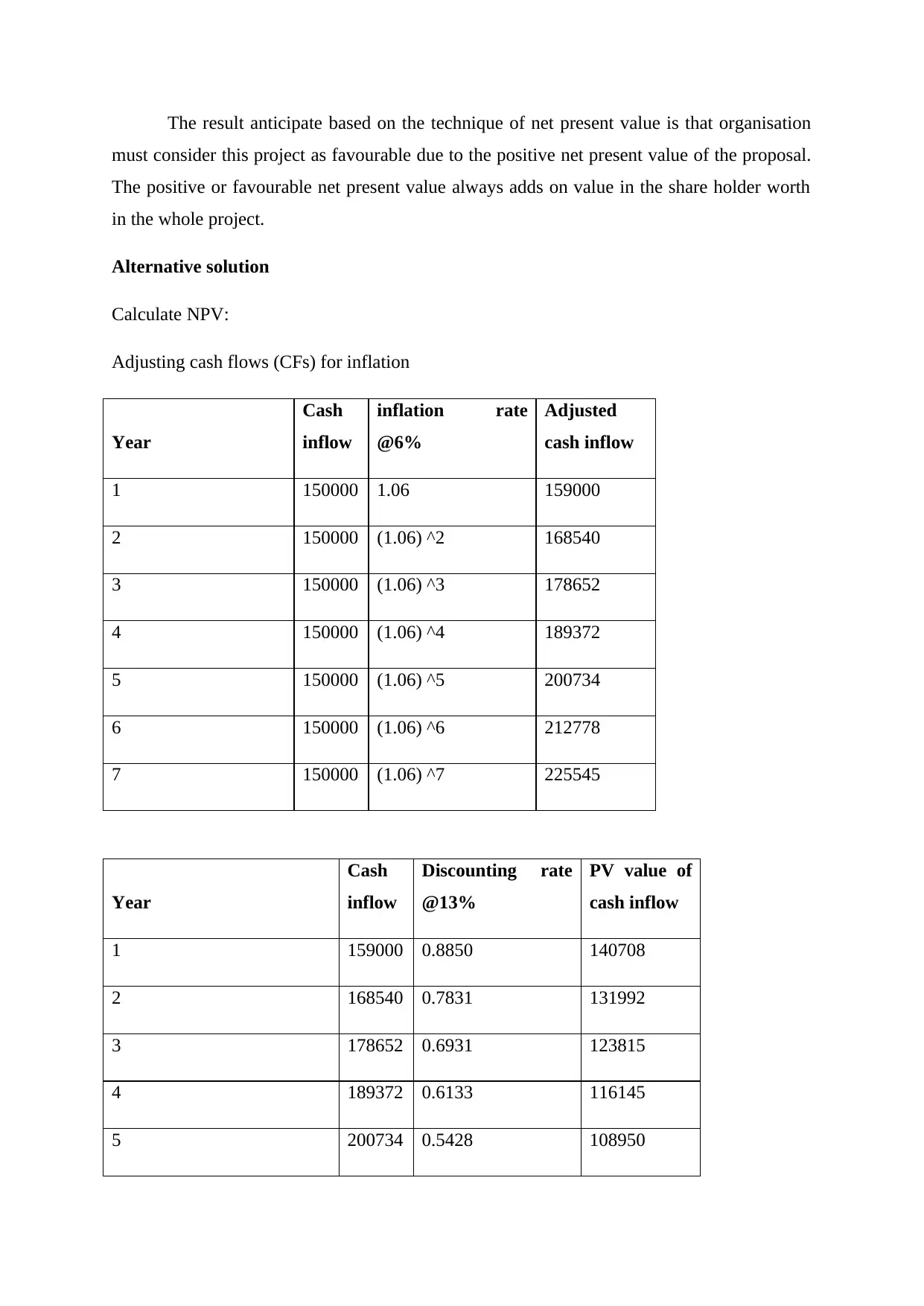
The result anticipate based on the technique of net present value is that organisation
must consider this project as favourable due to the positive net present value of the proposal.
The positive or favourable net present value always adds on value in the share holder worth
in the whole project.
Alternative solution
Calculate NPV:
Adjusting cash flows (CFs) for inflation
Year
Cash
inflow
inflation rate
@6%
Adjusted
cash inflow
1 150000 1.06 159000
2 150000 (1.06) ^2 168540
3 150000 (1.06) ^3 178652
4 150000 (1.06) ^4 189372
5 150000 (1.06) ^5 200734
6 150000 (1.06) ^6 212778
7 150000 (1.06) ^7 225545
Year
Cash
inflow
Discounting rate
@13%
PV value of
cash inflow
1 159000 0.8850 140708
2 168540 0.7831 131992
3 178652 0.6931 123815
4 189372 0.6133 116145
5 200734 0.5428 108950
must consider this project as favourable due to the positive net present value of the proposal.
The positive or favourable net present value always adds on value in the share holder worth
in the whole project.
Alternative solution
Calculate NPV:
Adjusting cash flows (CFs) for inflation
Year
Cash
inflow
inflation rate
@6%
Adjusted
cash inflow
1 150000 1.06 159000
2 150000 (1.06) ^2 168540
3 150000 (1.06) ^3 178652
4 150000 (1.06) ^4 189372
5 150000 (1.06) ^5 200734
6 150000 (1.06) ^6 212778
7 150000 (1.06) ^7 225545
Year
Cash
inflow
Discounting rate
@13%
PV value of
cash inflow
1 159000 0.8850 140708
2 168540 0.7831 131992
3 178652 0.6931 123815
4 189372 0.6133 116145
5 200734 0.5428 108950
Paraphrase This Document
Need a fresh take? Get an instant paraphrase of this document with our AI Paraphraser
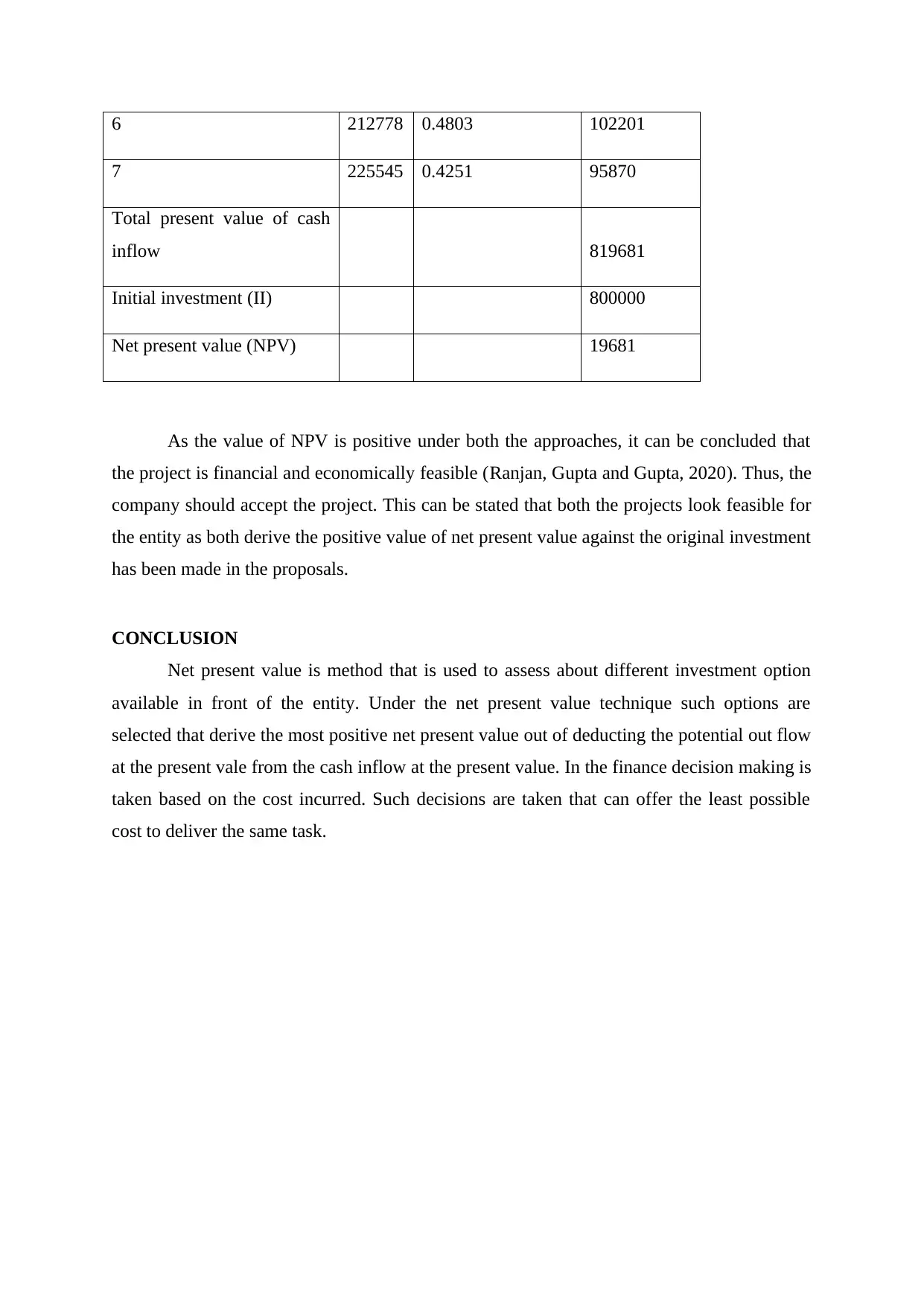
6 212778 0.4803 102201
7 225545 0.4251 95870
Total present value of cash
inflow 819681
Initial investment (II) 800000
Net present value (NPV) 19681
As the value of NPV is positive under both the approaches, it can be concluded that
the project is financial and economically feasible (Ranjan, Gupta and Gupta, 2020). Thus, the
company should accept the project. This can be stated that both the projects look feasible for
the entity as both derive the positive value of net present value against the original investment
has been made in the proposals.
CONCLUSION
Net present value is method that is used to assess about different investment option
available in front of the entity. Under the net present value technique such options are
selected that derive the most positive net present value out of deducting the potential out flow
at the present vale from the cash inflow at the present value. In the finance decision making is
taken based on the cost incurred. Such decisions are taken that can offer the least possible
cost to deliver the same task.
7 225545 0.4251 95870
Total present value of cash
inflow 819681
Initial investment (II) 800000
Net present value (NPV) 19681
As the value of NPV is positive under both the approaches, it can be concluded that
the project is financial and economically feasible (Ranjan, Gupta and Gupta, 2020). Thus, the
company should accept the project. This can be stated that both the projects look feasible for
the entity as both derive the positive value of net present value against the original investment
has been made in the proposals.
CONCLUSION
Net present value is method that is used to assess about different investment option
available in front of the entity. Under the net present value technique such options are
selected that derive the most positive net present value out of deducting the potential out flow
at the present vale from the cash inflow at the present value. In the finance decision making is
taken based on the cost incurred. Such decisions are taken that can offer the least possible
cost to deliver the same task.
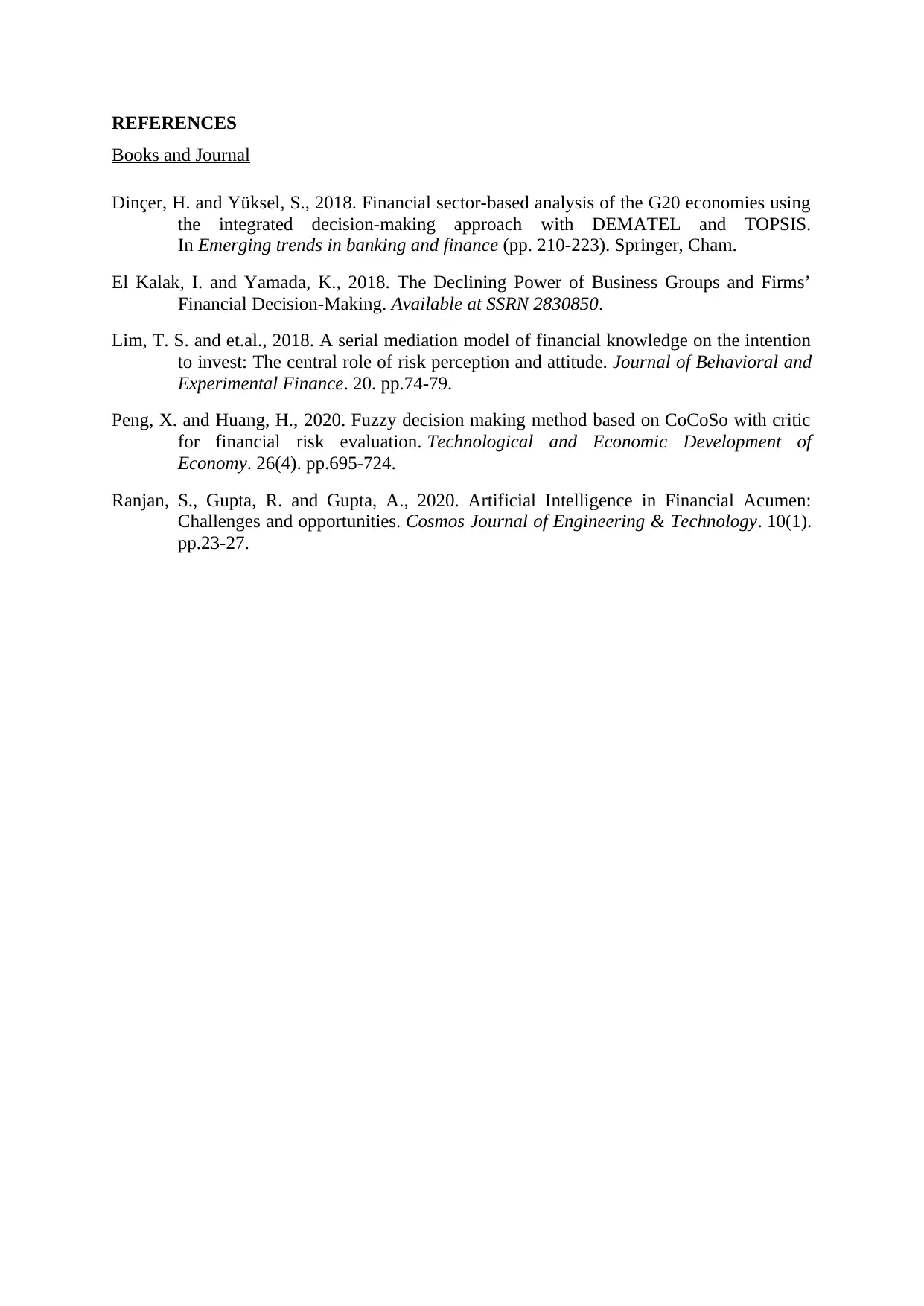
REFERENCES
Books and Journal
Dinçer, H. and Yüksel, S., 2018. Financial sector-based analysis of the G20 economies using
the integrated decision-making approach with DEMATEL and TOPSIS.
In Emerging trends in banking and finance (pp. 210-223). Springer, Cham.
El Kalak, I. and Yamada, K., 2018. The Declining Power of Business Groups and Firms’
Financial Decision-Making. Available at SSRN 2830850.
Lim, T. S. and et.al., 2018. A serial mediation model of financial knowledge on the intention
to invest: The central role of risk perception and attitude. Journal of Behavioral and
Experimental Finance. 20. pp.74-79.
Peng, X. and Huang, H., 2020. Fuzzy decision making method based on CoCoSo with critic
for financial risk evaluation. Technological and Economic Development of
Economy. 26(4). pp.695-724.
Ranjan, S., Gupta, R. and Gupta, A., 2020. Artificial Intelligence in Financial Acumen:
Challenges and opportunities. Cosmos Journal of Engineering & Technology. 10(1).
pp.23-27.
Books and Journal
Dinçer, H. and Yüksel, S., 2018. Financial sector-based analysis of the G20 economies using
the integrated decision-making approach with DEMATEL and TOPSIS.
In Emerging trends in banking and finance (pp. 210-223). Springer, Cham.
El Kalak, I. and Yamada, K., 2018. The Declining Power of Business Groups and Firms’
Financial Decision-Making. Available at SSRN 2830850.
Lim, T. S. and et.al., 2018. A serial mediation model of financial knowledge on the intention
to invest: The central role of risk perception and attitude. Journal of Behavioral and
Experimental Finance. 20. pp.74-79.
Peng, X. and Huang, H., 2020. Fuzzy decision making method based on CoCoSo with critic
for financial risk evaluation. Technological and Economic Development of
Economy. 26(4). pp.695-724.
Ranjan, S., Gupta, R. and Gupta, A., 2020. Artificial Intelligence in Financial Acumen:
Challenges and opportunities. Cosmos Journal of Engineering & Technology. 10(1).
pp.23-27.
⊘ This is a preview!⊘
Do you want full access?
Subscribe today to unlock all pages.

Trusted by 1+ million students worldwide
1 out of 9
Related Documents
Your All-in-One AI-Powered Toolkit for Academic Success.
+13062052269
info@desklib.com
Available 24*7 on WhatsApp / Email
![[object Object]](/_next/static/media/star-bottom.7253800d.svg)
Unlock your academic potential
Copyright © 2020–2025 A2Z Services. All Rights Reserved. Developed and managed by ZUCOL.





